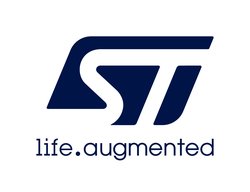NUCLEO-F303ZE
STM32 Nucleo-144 development board with STM32F303ZE MCU, supports Arduino, ST Zio and morpho connectivity.
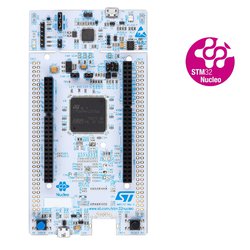
Overview¶
The STM32 Nucleo-144 board provides an affordable and flexible way for users to try out new concepts and build prototypes with the STM32 microcontroller, choosing from the various combinations of performance, power consumption and features. The ST Zio connector, which is an extension of Arduino™ Uno, provides access to more peripherals and ST morpho headers make it easy to expand the functionality of the Nucleo open development platform with a wide choice of specialized shields. The STM32 Nucleo-144 board does not require any separate probe, as it integrates the ST-LINK/V2-1 debugger/programmer and it comes with the STM32 comprehensive software HAL library, together with various packaged software examples, as well as a direct access to the ARM®mbed™online resources.
Microcontroller features¶
- STM32F303ZET6 in LQFP144 package
- Core: ARM® Cortex® -M4 32-bit CPU with 72 MHz FPU, single-cycle multiplication and HW division, 90 DMIPS (from CCM), DSP instruction and MPU (memory protection unit)
- Operating conditions: ◾VDD , VDDA voltage range: 2.0 V to 3.6 V
- Memories
- Up to 512 Kbytes of Flash memory
- 64 Kbytes of SRAM, with HW parity check implemented on the first 32 Kbytes.
- Routine booster: 16 Kbytes of SRAM on instruction and data bus, with HW parity check (CCM)
- Flexible memory controller (FSMC) for static memories, with four Chip Select
- CRC calculation unit
- Reset and supply management
- Power-on/Power-down reset (POR/PDR)
- Programmable voltage detector (PVD)
- Low power modes: Sleep, Stop and Standby
- VBAT supply for RTC and backup registers
- Clock management
- 4 to 32 MHz crystal oscillator
- 32 kHz oscillator for RTC with calibration
- Internal 8 MHz RC with x 16 PLL option
- Internal 40 kHz oscillator
- Up to 115 fast I/Os
- All mappable on external interrupt vectors
- Several 5 V-tolerant
- Interconnect matrix
- 12-channel DMA controller
- 4 x ADCs 0.20 μs (up to 40 channels) with selectable resolution of 12/10/8/6 bits, 0 to 3.6 V conversion range, separate analog supply from 2.0 to 3.6 V
- 2 x 12-bit DAC channels with analog supply from 2.4 to 3.6 V
- 7 x ultra-fast rail-to-rail analog comparators with analog supply from 2.0 to 3.6 V
- 4 x operational amplifiers that can be used in PGA mode, all terminals accessible with analog supply from 2.4 to 3.6 V
- Up to 24 capacitive sensing channels supporting touchkey, linear and rotary touch sensors
- Up to 14 timers
- 1 x 32-bit timer and 2 x 16-bit timers with up to four IC/OC/PWM or pulse counter and quadrature (incremental) encoder input
- 3 x 16-bit 6-channel advanced-control timers, with up to six PWM channels, deadtime generation and emergency stop
- 1 x 16-bit timer with two IC/OCs, one OCN/PWM, deadtime generation and emergency stop
- 2 x 16-bit timers with IC/OC/OCN/PWM, deadtime generation and emergency stop
- 2 x watchdog timers (independent, window)
- SysTick timer: 24-bit downcounter
- 2 x 16-bit basic timers to drive the DAC
- Calendar RTC with Alarm, periodic wakeup from Stop/Standby
- Communication interfaces
- 1 x CAN interface (2.0B Active)
- 3 x I2 C Fast mode plus (1 Mbit/s) with 20 mA current sink, SMBus/PMBus, wakeup from STOP
- Up to 5 x USART/UARTs (ISO 7816 interface, LIN, IrDA, modem control)
- Up to 4 x SPIs, 4 to 16 programmable bit frames, two with multiplexed half/full duplex I2S interface
- USB 2.0 full speed interface with LPM support
- Infrared transmitter
- SWD, Cortex® -M4 with FPU ETM, JTAG
- 96-bit unique ID
Nucleo features¶
- Two types of extension resources:
- ST Zio connector including: support for Arduino™ Uno V3 connectivity (A0 to A5, D0 to D15) and additional signals exposing a wide range of peripherals
- ST morpho extension pin header footprints for full access to all STM32 I/Os
- On-board ST-LINK/V2-1 debugger/programmer with SWD connector:
- Selection-mode switch to use the kit as a standalone ST-LINK/V2-1
- USB re-enumeration capability. Three different interfaces supported on USB: virtual COM port, mass storage, debug port
- Flexible board power supply:
- 5 V from ST-LINK/V2-1 USB VBUS
- External power sources: 3.3 V and 7 - 12 V on ST Zio or ST morpho connectors, 5 V on ST morpho connector
- USB OTG or full-speed device with Micro-AB connector
- Three user LEDs
- Two push-buttons: USER and RESET
- LSE crystal:
- 32.768 KHz crystal oscillator
Board Pinout¶
Pins Legend¶
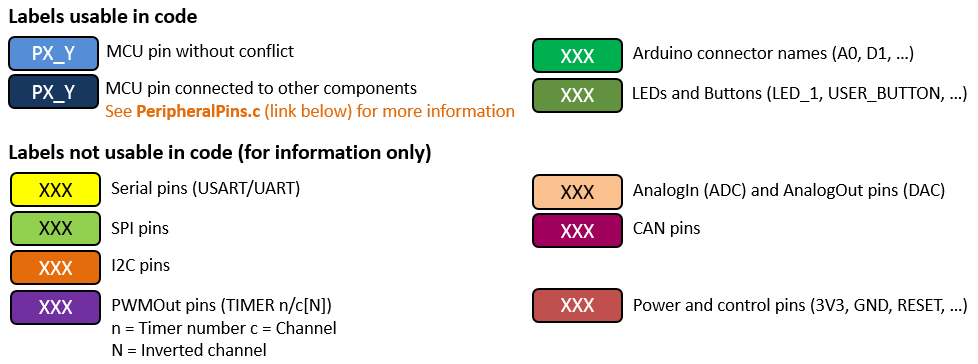
You can find more details on the available pins and labels in the PeripheralPins.c and PinNames.h files.
These files can be found in:
- ARMmbed/mbed-os repository on GitHub (up-to-date version, used with mbed CLI commands)
- mbed-dev library in developer.mbed.org (source files of the mbed library used on mbed compiler IDE)
Zio and Arduino-compatible headers¶
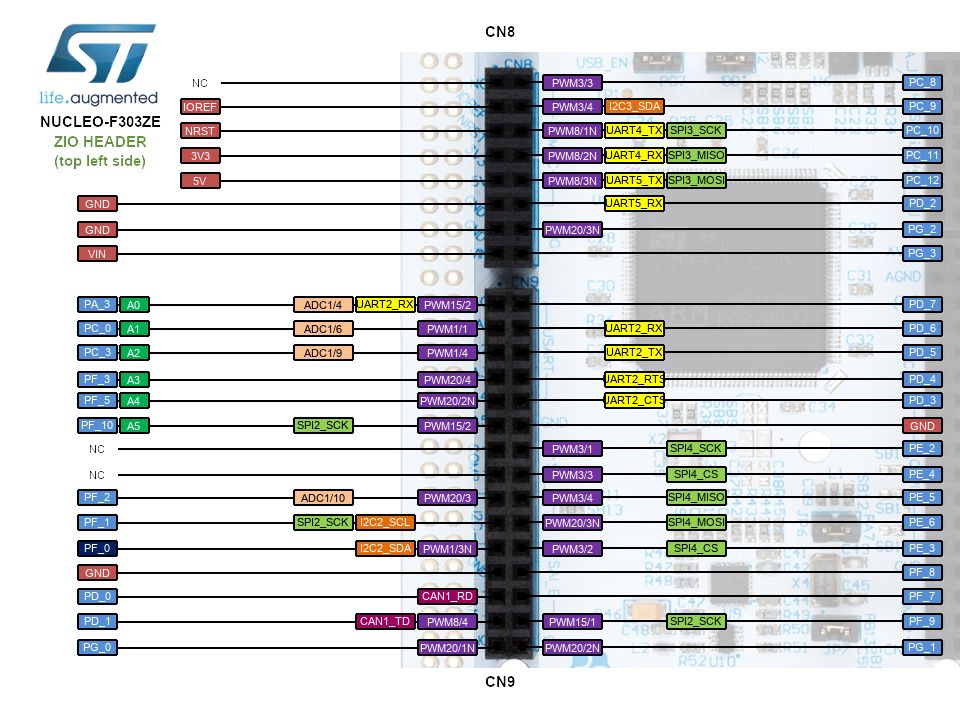
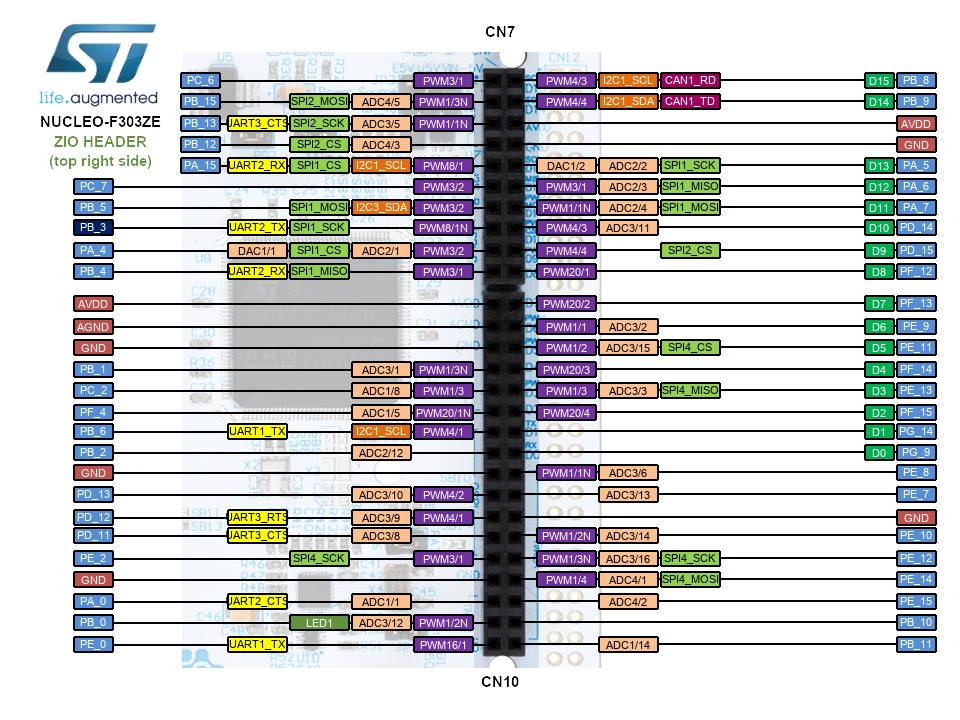
CN11 CN12 headers¶
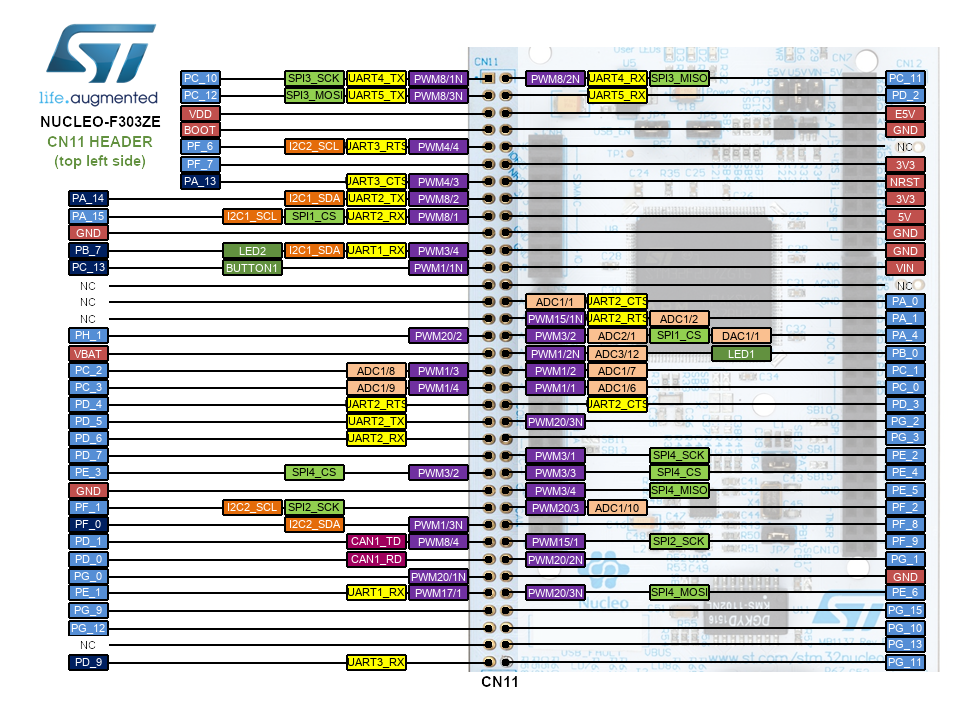
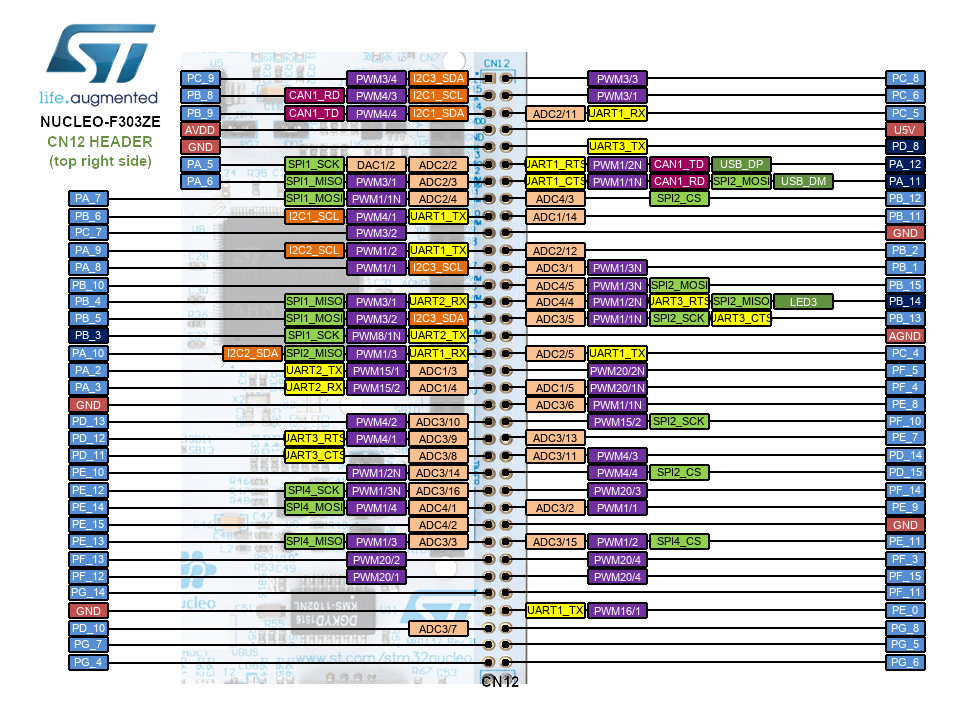
Getting started¶
This video shows how to get started with ARM mbed Integrated Development Environment using STM32 Nucleo platform:
Supported shields¶
ST X-NUCLEO boards¶
Other Non-ST boards¶
See here.
Technical references¶
For more information, please refer to:
Known limitations¶
The following section describes known limitations of the platform. Note that general issues are tracked into the mbed repository available on GitHub.
This platform does not present any limitation.
Tips and Tricks¶
Find more information in ST WIKI pages.
You need to log in to post a discussion
